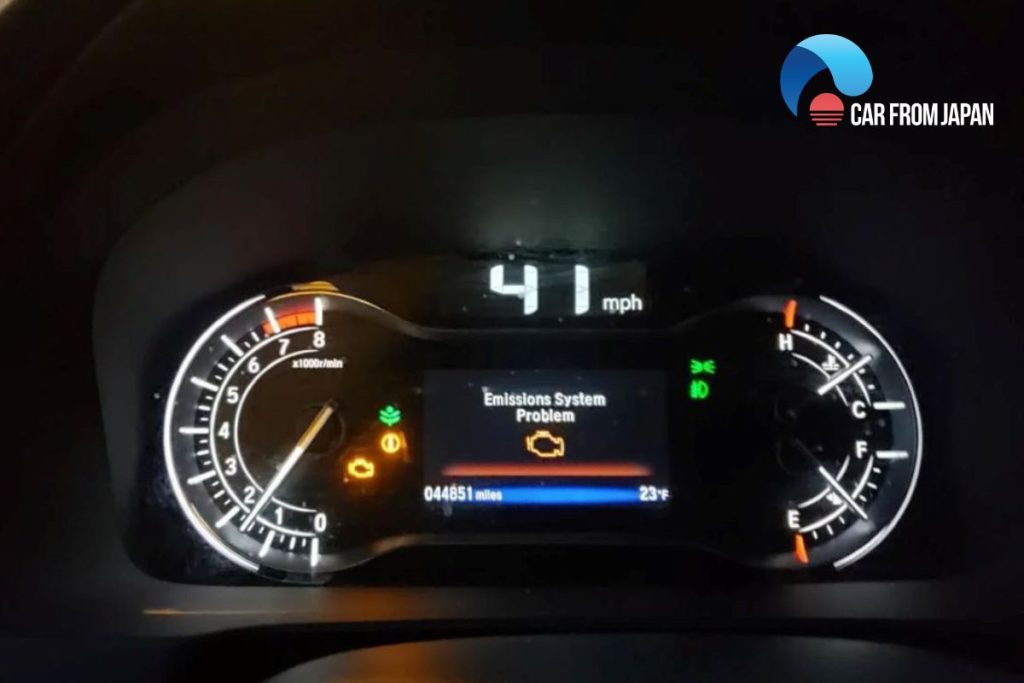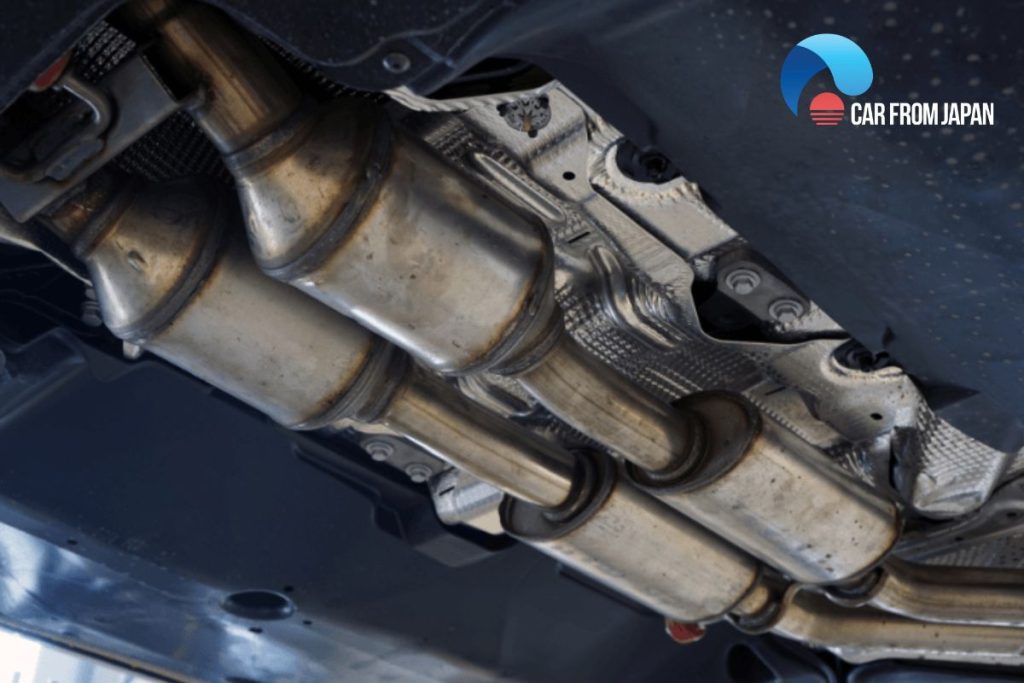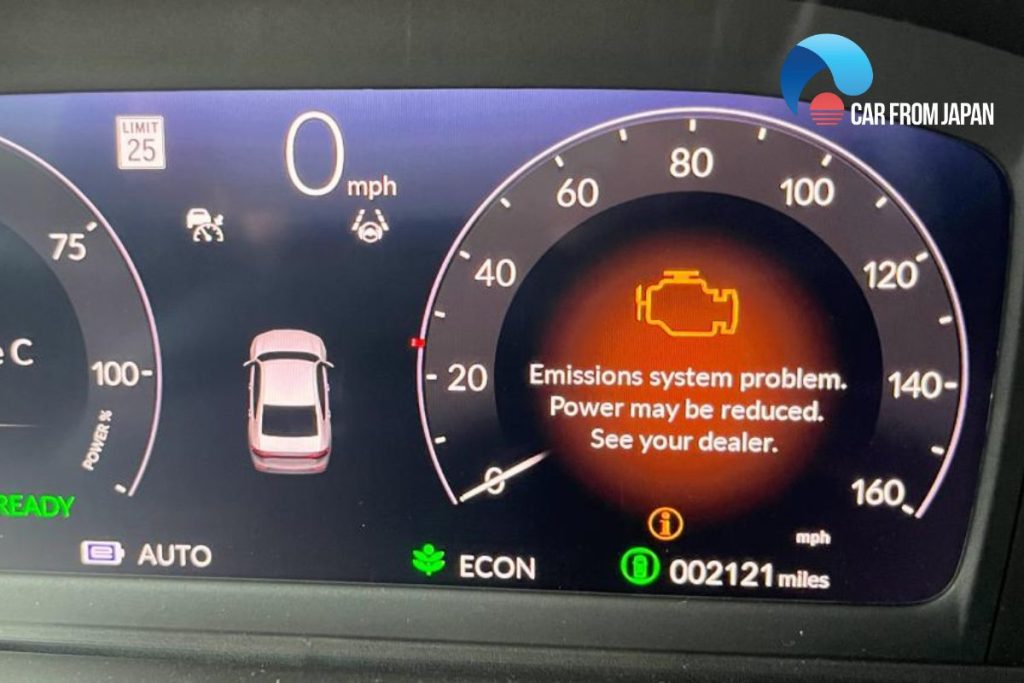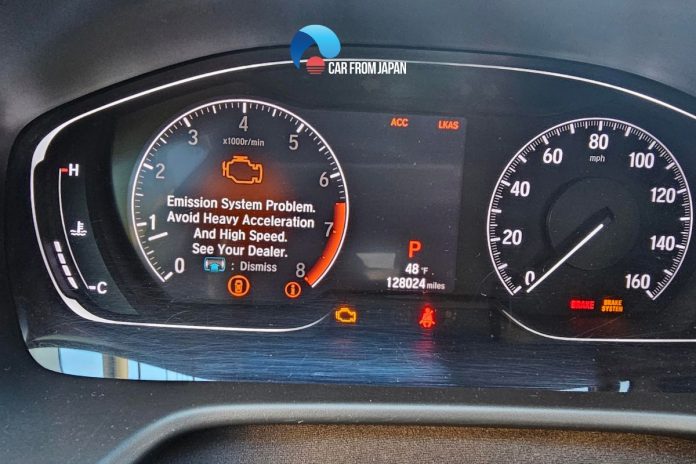Although Honda vehicles are known for their reliability and performance, like any complex machinery, Honda vehicles are not immune to occasional issues. And the emission system problem Honda is one of these.
Let’s go deep into this system issue and find out how to tackle them effectively with Car From Japan!
Contents
What Does Emissions System Problem Mean On Honda?
When you encounter an “emissions system problem”, it refers to an issue or malfunction within the vehicle’s emission control system. Like in any other model vehicle, Honda’s emission system is designed to reduce harmful pollutants emitted into the atmosphere as a result of the combustion process.
The emission control system in a Honda is structured based on various components that work together to minimize the release of pollutants such as nitrogen oxides (NOx), carbon monoxide (CO), and hydrocarbons (HC).
These components include the oxygen sensors, catalytic converter, exhaust gas recirculation (EGR) valve, evaporative emission control (EVAP) system, and more.
When the Honda’s onboard diagnostic system detects a problem or a deviation from the expected performance of the emission control components, it triggers the “emissions system problem” warning or check engine light on the dashboard.
Sometimes, it could be a simple issue like a loosened gasoline cap, however, you also need to have a quick diagnostic as soon as possible.
Emission System Problem Honda: What Are The Symptoms?
The symptoms of Honda’s emission system can vary depending on the specific issue affecting the emission control system. Here are some common signs to look out for.
Check engine light
The most obvious symptom of a Honda emission system problem is the illumination of the check engine light on the vehicle’s dashboard with the message “check emission system”. The check engine light serves as a warning that a problem has been detected.
However, it doesn’t provide specific details about the exact issue, so it’s important to have the vehicle scanned for diagnostic trouble codes (DTCs) to identify the problem.
Failed emission test
If you live in an area where periodic emissions testing is required, an emission system problem can cause your Honda to fail the test.
Failed emissions tests are often due to increased levels of pollutants being emitted from the vehicle, indicating a problem with the emission control system.

Unusual exhaust smoke
Let’s pay attention to the color and consistency of the exhaust smoke coming from the tailpipe as a sign of the
In some cases, an emission system problem can cause the exhaust smoke to be thicker, darker, or have an unusual color. Notice excessive white smoke, black smoke, or a strong odor in the exhaust to indicate issue ASAP.
Reduce fuel efficiency
Another symptom of a failed Honda’s emission system is a decrease in fuel efficiency. When you notice that your Honda is consuming more fuel than usual or that you’re having to refuel more frequently, it could be a sign of a problem.
Rough idling
Distinguished by an uneven engine vibration or shaking when the vehicle is stationary and in gear (or parked for automatic transmissions), rough idling can also potentially be caused by a malfunctioning emissions system on Honda vehicles.
READ MORE: 5 Common Causes of The Emission System Problem Honda Civic
What Are The Causes of The Honda Emission System Problem?
Some of the most common causes include malfunctioning oxygen sensors, exhaust leaks, faulty fuel injectors, the cylinder deactivation system (if equipped) and catalytic converter failure. Here’re some potential causes in more detail.
Oxygen sensor failure
These oxygen sensors are important in monitoring the amount of oxygen your car emits. They send information to the ECU so that the ECU can fine-tune the air-fuel mixture for optimal combustion.
When the sensor malfunctions, the combustion process can become inefficient and cause the vehicle to emit more pollutants. Not only that, it can significantly reduce the fuel economy of your Honda.
Bad catalytic converter
A faulty converter disrupts the process of converting pollutants into less harmful substances for the environment.
Emissions from your car into the environment can increase due to contamination from engine oil, coolant, or physical agents from the road that contaminate and weaken the system’s catalyst.

Faulty fuel Injectors
Fuel injector blockages and leaks can disrupt the balance between fuel delivery and combustion to keep your vehicle running.
If the injector is too low on fuel (a “lean” condition), the engine can overheat, causing damage to the catalytic converter and increased harmful emissions. Conversely, a rich fuel condition can also overload the system.
Exhaust system leak
A faulty exhaust system prevents exhaust gases from being filtered out into the atmosphere or allows harmful gases to escape without being processed by the catalytic converter.
When a problem occurs, pollutants from the fuel combustion process will leak directly into the environment, polluting the air and potentially triggering a warning light on your Honda’s dashboard.
EGR valve fault
Another reason for the emission system problem of your Honda is a malfunctioning EGR valve.
The valve works by diluting the air-fuel mixture, reducing combustion temperatures, and reducing the formation of toxic NOx, by recirculating a small portion of the exhaust gas back into the intake manifold.
Common EGR valve problems are stuck open or stuck closed. Either way, it can disrupt the exhaust gas treatment process.
Bad Mass Air Flow (MAF) sensor
A faulty mass air flow sensor will provide an incorrect reading of the air amount entering the engine, leading to an imbalance that results in poor performance, reduced fuel economy, and increased emissions.
How To Fix The Emission System Problem Honda?
Whenever you notice the error message “check emission system” on your Honda dashboard or any other symptoms we listed above, it’s time you fix or diagnose the emission system.
Ignoring or neglecting the issue can lead to some serious damages, which may result in the vehicle failing an emissions test or being non-compliant with environmental regulations.

Retrieve diagnostic trouble codes (DTCs)
When the check engine light illuminates, it indicates that the vehicle’s onboard diagnostic system has detected a problem.
The first step is to use a diagnostic scanner to retrieve the DTCs associated with the emission system problem. These codes provide specific information about the component or system that is experiencing the issue.
Check other parts of the emission system
You can inspect the various components of the emission control system to identify any visible signs of damage or malfunction. This may include checking the oxygen sensors, catalytic converter, EGR valve, EVAP system, and other related components.
Clear DTCs and test
After the repairs or component replacements have been performed, you can clear the DTCs from the vehicle’s onboard diagnostic system. The vehicle will then be tested to ensure that the emission system problem has been resolved.
This may involve a road test or using specialized equipment to verify that the system is functioning correctly and that emissions are within acceptable limits.
For more information, watch the check emission system Honda Civic problems to get a more visual guide on this problem!
FAQs about Honda Emission System Problem
Is it safe to drive a Honda with an emission system problem?
You can still drive the car, but it is unsafe, and you risk damaging the exhaust system.
Even if the car seems to be running smoothly, it may still operate in a limp mode state. Continuing to drive with a malfunction in the system will only make things worse, potentially damaging the oxygen sensor and catalytic converter.
Therefore, the safest thing to do is to pull over and seek professional assistance from a qualified mechanic nearby as soon as possible.
Do Honda hybrid models face more emission system problems than non-hybrids?
Hybrid vehicles can be more susceptible to emissions issues due to their complex engine management systems.
Frequent battery charging cycles, regenerative braking, and engine stop-start can put stress on emissions components such as catalytic converters and oxygen sensors.
Therefore, they can be more prone to emission system problems than conventional gasoline-powered vehicles.
How does extreme weather affect Honda’s emission system?
Any extreme weather event can cause problems with system components.
Extremely cold weather can cause condensation in the exhaust system, leading to temporary sensor failure. In contrast, hot weather can stress emissions control components such as the EGR valve and catalytic converter.
Why does Honda’s emission system problem appear after an oil change?
Changing the wrong oil will affect engine performance and emissions.
Furthermore, if the oil cap is not installed properly or too much oil is added, pressure-related problems will also appear, affecting the vehicle’s exhaust and emission system.
Conclusion
It’s important to note that all the information we shared about the emission problems may not be specific to all Honda vehicles, it will depend on each model and year.
Proper diagnosis by a qualified technician is crucial to identify the exact cause of the emission problem in a specific Honda vehicle.
If you have any concerns, don’t hesitate to leave a comment in the box below!
Bring a buyer – Earn $100
Our referral program is open to help you earn real money.
- You earn $100 for every successful referral.
- Your audience get $100 off on their purchase, when they use your referral code.
There’s no limit to the rewards you can earn, and no commitment require.




